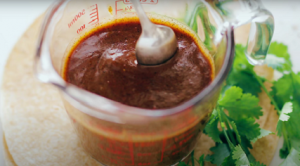This simple sweet and sour pork recipe captures the perfect balance of tangy and sweet. It's the ideal way to enjoy tender pieces of pork, sauteed in a flavorful sauce and served over fluffy white rice. The combination of fresh vegetables, pineapple, and the unique sweet and sour sauce creates a colorful, appetizing, and incredibly tasty dish that will transport your taste buds to the heart of Asian cuisine.
Most of the ingredients required for this recipe are rather common in any household. However, keep an eye out for 'pork shoulder', a cut of meat that might not be readily available in your fridge but can be easily found at the supermarket's meat section. The 'pineapple with syrup' is another ingredient that you might need to pick up from the store, available in the canned fruits aisle.
Sweet and Sour Pork Ingredients
Pork shoulder: This is a flavorful cut of meat that becomes incredibly tender and juicy when cooked properly.
Garlic: Adds a pungent kick to the marinade and helps to deepen the overall flavor profile.
Black pepper: Adds a touch of heat and enhances the other flavors in the dish.
Green onion: Offers a mild, sweet flavor and a vibrant color to the dish.
Soy sauce: This sauce adds a salty, umami flavor to the dish.
Vegetable oil: Used for frying the pork to a golden-brown perfection.
Eggs: Helps the cornstarch stick to the pork for a crispy coating.
Cornstarch: It helps to create a light, crispy coating on the pork.
White onion: Adds a sweet and tangy crunch that contrasts with the soft pork.
Red bell pepper: Provides a bright color and sweet flavor to the dish.
Green bell pepper: Similar to the red bell pepper, it adds color and sweetness.
Pineapple with syrup: The pineapple adds a tart sweetness to the sauce, while the syrup thickens it.
Vinegar: Vinegar brings the 'sour' to the sweet and sour sauce.
Sugar: Balances out the tanginess of the vinegar.
Ketchup: Adds a sweet and tangy flavor and helps to thicken the sauce.
White rice: Serves as a neutral base that soaks up the sweet and sour sauce.
One reader, Grover Blalock says:





This simple sweet and sour pork recipe is a game-changer! The flavors are perfectly balanced, and the pork turns out so tender and delicious. The step-by-step instructions made it easy to follow, and the end result was a hit with my family. I'll definitely be making this again!
Techniques Required for Making Sweet and Sour Pork
Marinating the pork: Combine the pork with garlic, pepper, green onions, and soy sauce, then refrigerate for 1 to 2 hours to allow the flavors to infuse.
Frying the pork: Coat the marinated pork in egg and cornstarch, then fry in hot oil until golden brown and crispy.
Making the sweet and sour sauce: Sauté the onion and bell peppers, then add pineapple, vinegar, soy sauce, sugar, and ketchup. Stir constantly until the sauce thickens.
Serving the dish: Serve the sweet and sour pork over rice and garnish with green onions if desired.
How To Make Simple Sweet and Sour Pork
Sweet and sour pork is popular in Chinese restaurants. Recreate this dish by using pineapple syrup and soy sauce as flavorings and pair it with rice.
Serves:
Ingredients
- 2lbspork shoulder,or pork butt
- 2clovesgarlic,minced
- 1tspblack pepper
- ¼cupgreen onion
- ½cupsoy sauce,divided
- 2tbspvegetable oil,plus more for frying
- 3eggs,beaten
- 1½cupscornstarch
- 1white onion,chopped
- 1red bell pepper
- 1green bell pepper
- 8ozpineapple with syrup,chopped
- ¼cupvinegar
- ¼cupsugar
- ¼cupketchup
- 4½cupswhite rice,cooked for serving
Instructions
-
Cube the pork and place in a medium bowl.
-
Add the garlic, pepper, green onions, and ¼ cup soy sauce. Toss to coat the pork.
-
Cover with plastic wrap and marinate in the refrigerator for 1 to 2 hours.
-
Heat about 2-inches of vegetable oil in a large pan over medium heat until it reaches 350 degrees F.
-
Add the eggs and cornstarch to 2 separate small bowls. Coat the pork in the egg, then in the cornstarch.
-
Fry the pork in the hot oil until golden brown. Drain on paper towels.
-
Heat the remaining vegetable oil in a clean large pan over medium-high heat. Add the onion and bell peppers and sauté until tender.
-
Once the vegetables are tender, add the pineapple and syrup. Stir for 30 seconds, then add the vinegar, remaining soy sauce, sugar, and ketchup.
-
Stir constantly for 3 to 4 minutes, until the liquid evaporates and the sauce thickens.
-
Add the pork to the pan and toss to coat evenly.
-
Serve the pork over rice and garnish with green onions, if desired. Enjoy!
Nutrition
- Calories: 1173.94kcal
- Fat: 35.09g
- Saturated Fat: 10.70g
- Trans Fat: 0.04g
- Monounsaturated Fat: 16.56g
- Polyunsaturated Fat: 4.46g
- Carbohydrates: 167.47g
- Fiber: 2.37g
- Sugar: 16.63g
- Protein: 41.25g
- Cholesterol: 187.33mg
- Sodium: 1394.91mg
- Calcium: 77.70mg
- Potassium: 903.24mg
- Iron: 4.06mg
- Vitamin A: 78.00µg
- Vitamin C: 63.08mg
Crucial Technique Tip for Perfect Sweet and Sour Pork
When frying the pork, it's important to not overcrowd the pan. Adding too many pieces at once can lower the temperature of the oil, resulting in a less crispy and more greasy end product. Fry the pork in batches if necessary, and make sure each piece has enough room to cook evenly. This will ensure your pork is golden brown and crispy, just as it should be in a sweet and sour pork dish.
Time-Saving Tips for Preparing This Recipe
Prep ahead: Marinate the pork the night before to save time on the day of cooking. This allows the flavors to develop and reduces the prep time when you're ready to cook.
Efficient setup: Set up a breading station for the pork by arranging the bowls of beaten eggs and cornstarch in a systematic manner to streamline the coating process.
Organized ingredients: Chop and prepare all the ingredients before you start cooking to create a smooth and efficient cooking process.
Multitasking: While the pork is marinating, use that time to chop the vegetables and prepare the sauce to save time during the actual cooking process.
Batch cooking: Consider making a larger batch and freezing the extra portions for future quick and easy meals.
Substitute Ingredients For Simple Sweet and Sour Pork Recipe
pork shoulder - Substitute with chicken thighs: Chicken thighs are a flavorful and tender alternative to pork shoulder, and they work well in sweet and sour dishes.
soy sauce - Substitute with tamari: Tamari is a gluten-free alternative to soy sauce with a rich umami flavor that works well in this recipe.
vegetable oil - Substitute with sesame oil: Sesame oil adds a nutty flavor that complements the sweet and sour flavors in the dish.
cornstarch - Substitute with tapioca starch: Tapioca starch is a great gluten-free alternative to cornstarch for thickening the sweet and sour sauce.
white onion - Substitute with yellow onion: Yellow onions have a slightly sweeter flavor compared to white onions, which can enhance the overall sweetness of the dish.
red bell pepper - Substitute with orange bell pepper: Orange bell peppers have a similar sweetness and crunch to red bell peppers, making them a great substitute in this recipe.
green bell pepper - Substitute with yellow bell pepper: Yellow bell peppers have a milder, slightly sweet flavor that works well in sweet and sour dishes.
pineapple with syrup - Substitute with fresh pineapple: Fresh pineapple adds a vibrant, sweet flavor and juicy texture to the dish without the added syrup.
vinegar - Substitute with rice vinegar: Rice vinegar has a milder and slightly sweet flavor compared to regular vinegar, which complements the sweet and sour profile of the dish.
sugar - Substitute with honey: Honey adds a natural sweetness and depth of flavor to the sweet and sour sauce.
white rice - Substitute with jasmine rice: Jasmine rice has a fragrant aroma and slightly sticky texture that pairs beautifully with sweet and sour pork.
Best Way to Present This Delicious Dish
Elevate the plating: Present the sweet and sour pork in a visually appealing manner, ensuring that each component is showcased beautifully on the plate.
Incorporate color contrast: Utilize the vibrant colors of the bell peppers and pineapple to create a visually striking and appetizing presentation.
Garnish with precision: Add a final touch of finesse by garnishing the dish with finely chopped green onions, strategically placed to enhance the overall aesthetic.
Balance the elements: Arrange the pork, vegetables, and rice in a harmonious manner, ensuring that each component complements the others in both flavor and appearance.
Utilize elegant serving dishes: Choose sophisticated and stylish serving dishes that complement the dish and elevate the overall dining experience.
Focus on symmetry and composition: Pay attention to the placement of each element on the plate, aiming for a balanced and visually pleasing composition.
Emphasize the sauce: Drizzle the sweet and sour sauce over the pork with precision, creating an enticing visual appeal and highlighting the flavors of the dish.
Consider the plate as a canvas: Approach the plating as an art form, using the plate as a canvas to create a visually stunning masterpiece that reflects the culinary excellence of the dish.
Essential Tools for Making Sweet and Sour Pork
- Cutting board: A flat surface used for cutting, slicing, and preparing ingredients.
- Chef's knife: A versatile kitchen knife used for chopping, slicing, and dicing.
- Wok: A versatile round-bottomed cooking vessel used for stir-frying, steaming, and deep-frying.
- Tongs: Kitchen utensils used for gripping and lifting.
- Deep fryer: A kitchen appliance used for deep-frying foods.
- Large pan: A wide, shallow cooking vessel used for sautéing, frying, and stir-frying.
- Small bowls: Used for holding and organizing prepped ingredients.
- Paper towels: Used for draining and absorbing excess oil from fried foods.
- Spatula: A kitchen tool with a broad, flat, flexible blade used for lifting and flipping foods.
- Measuring cups and spoons: Used for accurately measuring ingredients.
- Whisk: A kitchen utensil used for blending, whipping, and beating ingredients.
- Plates: Used for serving the finished dish.
- Serving spoon: A large spoon used for serving food.
Storing and Freezing Sweet and Sour Pork
- Let the sweet and sour pork cool completely before storing it in an airtight container in the refrigerator. It will keep for up to 4 days.
- To freeze the sweet and sour pork, place it in a freezer-safe container or resealable plastic bag. Make sure to remove as much air as possible to prevent freezer burn.
- Label the container or bag with the date and contents, so you can easily keep track of when it was frozen.
- The frozen sweet and sour pork will keep for up to 3 months in the freezer.
- To reheat, thaw the pork in the refrigerator overnight. Then, heat it in a pan over medium heat until it's warmed through, stirring occasionally. You may need to add a splash of water or chicken broth to help loosen up the sauce.
- Alternatively, you can reheat the pork in the microwave. Place it in a microwave-safe dish, cover it with a damp paper towel, and heat it in 30-second intervals until it's heated through.
- If you find that the sauce has thickened too much after freezing and reheating, you can thin it out with a little water, chicken broth, or pineapple juice until it reaches your desired consistency.
- Serve the reheated sweet and sour pork over freshly cooked rice for the best texture and flavor.
How To Reheat Sweet and Sour Pork Leftovers
Reheat in a skillet or wok over medium-high heat. Add a small amount of oil or water to the pan to prevent sticking and to help steam the pork. Stir frequently until heated through, about 5-7 minutes. This method helps to retain the crispy texture of the pork.
Microwave in a covered microwave-safe dish. Add a tablespoon of water or chicken broth to the dish to help keep the pork moist. Heat on high for 1-2 minutes, stirring halfway through. Let stand for 30 seconds before serving. This is a quick and easy method, but the pork may lose some of its crispiness.
Reheat in the oven. Preheat the oven to 350°F (175°C). Place the sweet and sour pork in an oven-safe dish and cover with foil. Bake for 10-15 minutes, or until heated through. Remove the foil for the last 2-3 minutes of reheating to help crisp up the pork. This method is ideal for larger portions and helps to maintain the dish's overall texture.
Use an air fryer. Preheat the air fryer to 350°F (175°C). Place the leftover pork in the air fryer basket, ensuring the pieces are not overcrowded. Cook for 3-5 minutes, shaking the basket halfway through, until the pork is heated through and crispy. This method is perfect for restoring the crispy exterior of the fried pork.
Reheat on the stovetop with the sauce. In a saucepan, combine the leftover sweet and sour sauce with a tablespoon of water or pineapple juice. Heat over medium heat until simmering. Add the pork and stir gently to coat with the sauce. Cook for 2-3 minutes, or until the pork is heated through. This method ensures the pork is well-coated with the flavorful sauce.
Interesting Fact About Sweet and Sour Pork
The sweet and sour pork recipe is a popular dish in Chinese cuisine. It is believed to have originated from the Cantonese region and has become a staple in many Chinese restaurants worldwide. The combination of tangy pineapple, savory pork, and sweet and sour sauce creates a delicious and flavorful dish that is loved by many. This dish is often served with steamed white rice, providing a perfect balance of flavors and textures. The sweet and sour pork recipe is a great example of the harmonious blend of sweet and savory flavors in Chinese cooking.
Is Making Sweet and Sour Pork at Home Cost-Effective?
This sweet and sour pork recipe is quite cost-effective for a household. The key ingredients like pork, vegetables, and rice are budget-friendly and readily available. The versatility of the ingredients also allows for variations based on seasonal produce and personal preferences. The approximate cost for a household of 4 people would be around $20-$25, making it an economical choice. The overall verdict for this recipe would be 8/10, considering its affordability, delicious flavors, and the ability to feed a family without breaking the bank.
Is This Sweet and Sour Pork Recipe Healthy?
This sweet and sour pork recipe, while delicious, is not particularly healthy. Here's why:
- The pork is deep-fried, which adds a significant amount of unhealthy fats to the dish.
- The sauce contains a high amount of sugar, which can contribute to obesity and other health issues when consumed in excess.
- The recipe lacks a significant amount of vegetables, which are essential for a balanced meal.
- White rice is used as a side dish, which is a refined carbohydrate that can cause blood sugar spikes.
To make this recipe healthier, consider the following suggestions:
- Instead of deep-frying the pork, try grilling, baking, or stir-frying it with a minimal amount of oil.
- Reduce the amount of sugar in the sauce by half, and replace some of it with natural sweeteners like honey or dates.
- Increase the amount and variety of vegetables in the dish. Consider adding carrots, broccoli, or snap peas for added nutrients and fiber.
- Swap the white rice for brown rice or quinoa, which are whole grains that provide more fiber, vitamins, and minerals.
- Use low-sodium soy sauce to reduce the overall salt content of the dish.
- Serve the sweet and sour pork with a side salad or steamed vegetables to balance out the meal.
Editor's Opinion on This Sweet and Sour Pork Recipe
This sweet and sour pork recipe offers a delightful balance of flavors and textures. The marinated pork, coated in a crispy cornstarch crust, pairs perfectly with the tangy and sweet sauce. The addition of bell peppers, onions, and pineapple adds a refreshing and colorful touch. However, to enhance the dish, consider adding a touch of ginger for depth and a splash of rice vinegar for extra acidity. Overall, this recipe provides a satisfying and classic sweet and sour pork dish that is sure to please the palate.
Enhance Your Simple Sweet and Sour Pork Recipe with These Unique Side Dishes:
Similar Recipes to Try If You Love Sweet and Sour Pork
Appetizers and Desserts That Complement This Recipe
Why trust this Simple Sweet and Sour Pork Recipe:
This recipe is a trusted classic, perfected over years of culinary expertise. The succulent pork shoulder is marinated in a blend of garlic, soy sauce, and green onions, ensuring rich flavors in every bite. The crispy texture is achieved through a delicate coating of cornstarch and egg, creating a perfect balance with the sweet and tangy pineapple and bell peppers in the savory sauce. Each step is carefully crafted to deliver a delightful sweet and sour pork that will elevate your home cooking experience.
Was this page helpful?
Have your own special recipe to share? Submit Your Recipe Today!













-recipe-300x167.png)

